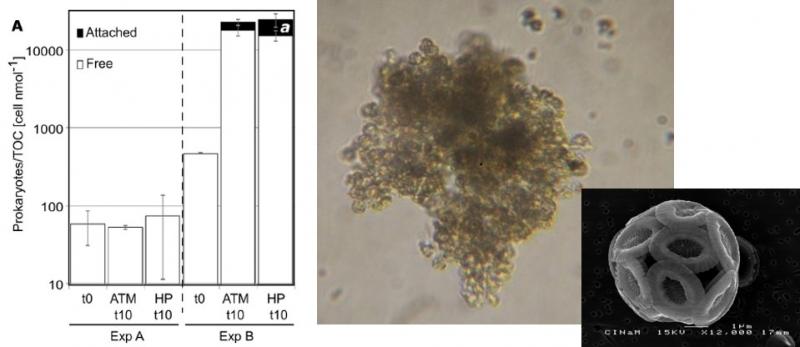Christian Tamburini (MIO)
Virginie Riou (post-doc OT-Med)
Kazuyo Tachikawa (CEREGE)
Frédéric Le Moigne (GEOMAR)
The project aims at understanding the complex interactions between mineral and sinking organic carbon in the ocean, in the context of the biological carbon pump (BCP). The BCP annually transfers 5-15 GT C yr-1 from the atmosphere to the ocean’s interior in the form of sinking particles with an organic component. As these particles sink they are remineralised with the constituent elements (incl. Carbon) returning to solution. If a link exists between the particles remineralisation depth and their mineral concentration (calcite, opal or dust), we can expect changes in air-sea CO2 partitioning resulting from ocean acidification and/or change in aerosol deposition. It is therefore critical to understand the factors regulating remineralisation depth in order to assess how ocean biological processes respond to and contribute to regulate the global climate. To date, no direct in situ observation of OM remineralisation depth combined with the assessment of the mineral content of sinking particles has been performed.
In the ROBIN project, controled experiments in the lab and field experiments (in the North Atlantic Porcupine Abyssal Plain, and the Mediterranean Sea) help evaluate the role of ballast minerals in regulating particle decomposition in the mesopelagic zone using pressurized incubation chambers (PASS-PArticles Sinking Simulator) and modified sediment traps (Marine Snow Catcher, lent by the National Oceanography Centre).
The ROBIN project is structured around two objectives:
(i) Determining whether organic carbon mineralization rate is a function of mineral to organic carbon ratios in sinking particles and
(ii) Assessing whether or not bacteria and/or ectoenzymes are excluded from within mineral associated particles.
Current seawater acidification, temperature increase, and changes in atmospheric dust deposition linked to climate changes, influence the mineral composition of particles sinking down the oceans. This might affect the transfer of atmospheric CO2 by the biological carbon pump to the ocean’s interior in the form of organic particles. The ROBIN project showed that the increase in hydrostatic pressure, experienced by particles sinking down the ocean, enhances cell lysis and aggregation in coccolithophorid algae (protected by a calcite mineral envelope), and stimulates the development of Mediterranean prokaryotic communities attached to these aggregates (Figure below). With a similar experiment performed with surface natural prokaryotic assemblage from NE Atlantic Ocean, we demonstrated that:
- diversity and active fraction (characterized by 16S Miseq sequencing, 16S DNA and 16S RNA) were affected by increasing pressure conditions
- organic carbon degradation by particle-attached microbes increased with depth, without any direct evidence for the influence of particle mineral content
(A) Riou et al., 2016. Calcite-sheathed coccolithophorid Emiliania huxleyi aggregates biodegradation Exp. A (no natural prokaryotes added: control) and Exp. B (natural prokaryotic community added): total abundance of prokaryotes (DAPI-stained cells) normalized by sample TOC concentration initially (t0) and after 10 days under constant atmospheric pressure (ATMt10) or increasing hydrostatic pressure (HPt10). White bars: free-living prokaryotes; Black bars: >2 µm particle-attached prokaryotes; Significant differences between ATM and HP are indicated as a (Mann-Whitney p < 0.05). (B) Pictures of an Emiliania huxleyi aggregate (top left, photon microscope) and cell (bottom right, electron microscope).



